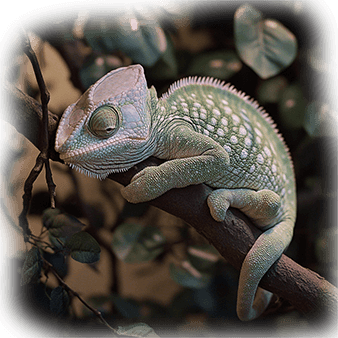Chameleons as Pets: A Colorful and Curious Companion

Chameleons are fascinating creatures, and keeping one as a pet can be a rewarding experience if you’re prepared for their specific needs. They’re not like your typical cat or dog—they require more careful attention and a specialized environment. However, if you’re drawn to the idea of having a pet with a unique charm, their mesmerizing color changes, curious personalities, and stunning appearance will certainly keep you captivated.
What Chameleons Are All About
Chameleons are best known for their color-changing ability, but this talent is often misunderstood. They don’t just shift hues to blend into their surroundings (though that can happen)—it’s also about regulating temperature, communicating mood, and attracting mates. Their colors can reflect anything from stress to relaxation, happiness to irritation.
These lizards are arboreal, meaning they spend most of their time in trees. They love climbing and prefer a tall enclosure with plenty of vertical space. If you’re setting up a habitat for one, make sure to include lots of plants and branches to mimic their natural environment.

Chameleon Sleep Patterns
Chameleons are diurnal—this means they’re active during the day and sleep at night. They prefer a steady light cycle, typically around 10 to 12 hours of light followed by darkness for the same amount of time. Unlike mammals, they don’t require darkness to sleep, but they do need a quiet and calm environment. When they sleep, they often grip a branch tightly and remain still, closing their eyes and becoming unresponsive. Fun fact—some chameleons even change to pale colors while sleeping!

Feeding Time – What Do Chameleons Eat?
Chameleons are insectivores—meaning their diet primarily consists of insects. Crickets, roaches, mealworms, and waxworms are staple foods for them, but variety is key to keeping them healthy. Gut-loading your feeder insects (feeding them nutritious food before offering them to your chameleon) ensures your pet gets all the necessary nutrients. Dusting the insects with calcium and vitamin supplements is also crucial, especially to prevent metabolic bone disease.
Hydration is just as important, but chameleons don’t drink from standing water. Instead, they drink droplets from leaves, so it’s essential to mist their enclosure several times a day or invest in a drip system. A dehydrated chameleon will display sunken eyes and lackluster skin color, so keeping them well-hydrated is a must.

Chameleon Behavior Around Humans
Chameleons are solitary creatures—this is something important to remember if you’re considering one as a pet. They aren’t naturally affectionate or social like dogs or cats, and they tend to prefer being left alone most of the time. Handling them too much can lead to stress, which in turn can affect their health.
That said, every chameleon has a unique personality, and some tolerate human interaction better than others. Patience is key when bonding with your chameleon. If you need to handle them, make sure it’s gentle and brief—try letting them crawl onto your hand rather than forcing them to be picked up.

Activity Level and Habits
Chameleons are generally calm and slow-moving, but they’re always alert and observant. You’ll often see them eyeing their surroundings with their trademark rotating eyes, which can move independently of each other. This gives them a 360-degree view, which is vital for spotting prey and potential threats.
One quirky fact about chameleons—many species use their prehensile tails to help grip branches as they move around. This tail functions almost like a fifth limb and helps them keep their balance in the treetops. It’s a trait that sets them apart from other reptiles.

Interesting Facts About Chameleons as Pets
- Color Change Mastery—Chameleons have specialized pigment cells called chromatophores that allow them to change colors. This ability varies by species, and not all chameleons have the same range of color-changing abilities.
- Eyes on the Prize—A chameleon’s eyes can move independently of each other, allowing them to focus on two different things at once. This helps them spot predators while simultaneously hunting prey.
- Sticky Tongue Tricks—Their tongues can be twice the length of their body and are incredibly fast. When they shoot out their sticky tongues to catch an insect, it happens in a split second—blinking and you’ll miss it!
- Long Lifespan—Chameleons can live up to 7 to 10 years with proper care, but this depends on the species. Panther and Veiled chameleons are among the most popular as pets due to their striking appearance and hardy nature.

Wrapping Up
Chameleons are fascinating, low-maintenance (in some ways) pets, but they require a specific environment and care routine to thrive. They’re not the type of pet that craves human interaction, but they’re perfect for reptile enthusiasts who love watching animals in a more natural setting. If you’re willing to invest the time and effort into creating the right habitat and meeting their needs, owning a chameleon can be a deeply rewarding experience.
Further reading: “Chameleon Care: The Complete Guide to Caring for and Keeping Chameleons as Pets” (Amazon affiliate link) by Tabitha Jones.
Affiliate Disclosure
This post may contain affiliate links, which means I earn from purchases made through links. Please see the privacy policy page for more details.






